When it comes to landscapes and karst landscapes, do you only think of Guilin? Guizhou is the only province in China without a plain.
The Qianxinan Ring Road not only passes through the traditional areas of Qianxinan Buyei and Miao Autonomous Prefecture, but also includes Guiyang, Anshun, Liupanshui, Bijie and other places. Along the route, there are not only traditional attractions such as Huangguoshu Waterfall and “The King of Chinese Caves” Zhijin Cave, but also newly popular internet check-in spots such as the Pink Muhly Grass Sea and Axilixi Big Grassland.
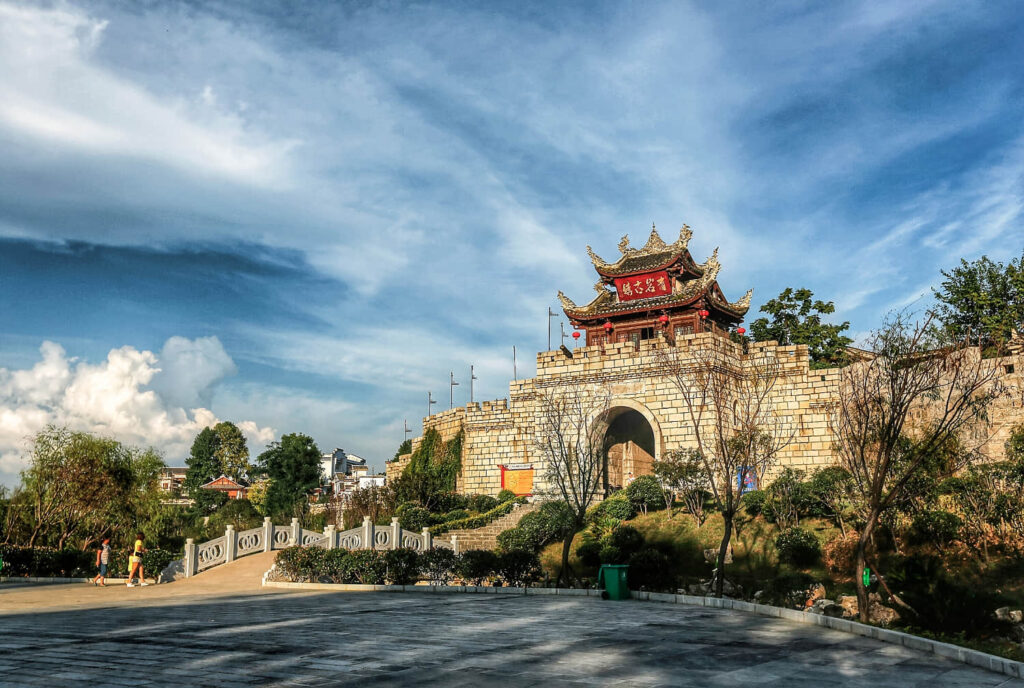
Besides the natural scenery, the Tunbao culture and Yelang culture complement each other, rich and colorful!
Whether you’re a seasoned traveler or someone who loves to explore from the comfort of your home, this blog has something for everyone. So, let’s dive in and discover the untapped wonders of Guizhou.
Tunbao Cultural Section
This route is rich in Karst topography, offering a new view with every step, from bustling city streets and vast flower-filled valleys, to love songs on the autumn slopes and the simple stone world. It’s a feast for the eyes.
First Stop: Guiyang
Compared to other cities in Guizhou, Guiyang’s tourist resources may not seem superior. However, as the provincial capital, it has developed transportation, and many travelers see it as a transit point.
In fact, Guiyang is the most suitable city for leisure vacations, If you’re willing to stay for three or four days, you’ll find this city full of surprises.
If you want to explore the leisurely lifestyle of Guiyang locals, you can go to spots like Jiaxiu Building, Nanming River, Qianling Mountain, etc.
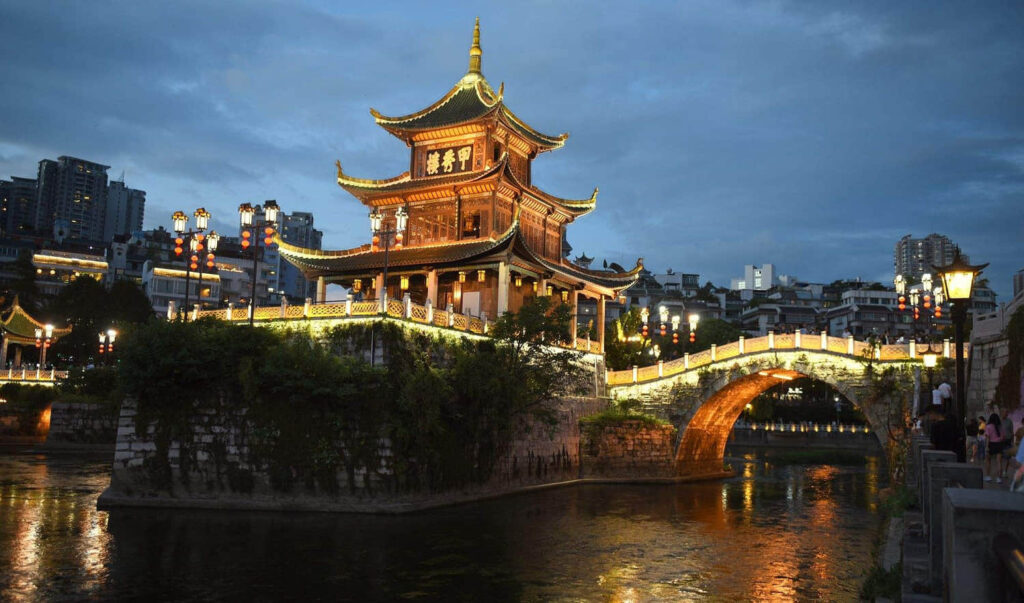
As a landmark of Guiyang, Jiaxiu Building is present in various promotional images and videos about the city. It’s also a popular spot to check in among traditional tourist destinations. Nowadays, it has gathered many places for dining, drinking, and entertainment.
If you find the hustle and bustle too much, you can follow the path along the side of the building, walk along the Nanming River, gradually move away from the noisy crowds, and feel the quiet and leisurely side of Guiyang.
In the golden autumn season at Hongfeng Lake, the maple leaves are as red as fire, and the lake is glittering. Feel free to stroll in this red oil painting, letting nature wash away all your worries and fatigue.
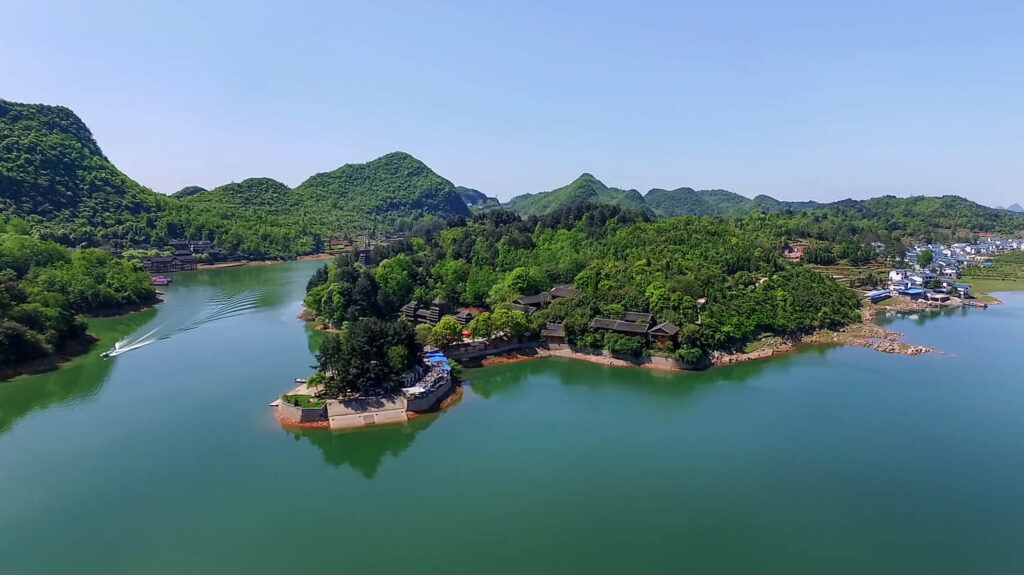
You can also take a boat tour of Tianhetan Water Cave, the nearest karst scenic area to Guiyang city center, wander through the deep alleys of the Qingyan Ancient Town, or visit the bizarre and absurd Huaxi Yelang Valley to see the devil stone carvings.
Taste Guiyang: Guiyang is a food paradise full of life. There are bean rice hot pot, mutton noodles, sour soup fish, bean paste nest, rolls, cake rake porridge, etc. You can check out local food streets like Zhengxin Street, Minsheng Road, Caijia Street, Huguo Road, etc., to explore more authentic foods.
Self-driving tips: Guiyang is about 98 kilometers away from Changshun, and it takes about 1 hour and 30 minutes to drive. Departing from Guiyang, take G212 through Huishui, change to G354 and drive all the way to Changshun.。
Second Stop: Changshun
Home of the Chinese Ginkgo King.
Leaving Guiyang, we arrived in Changshun.
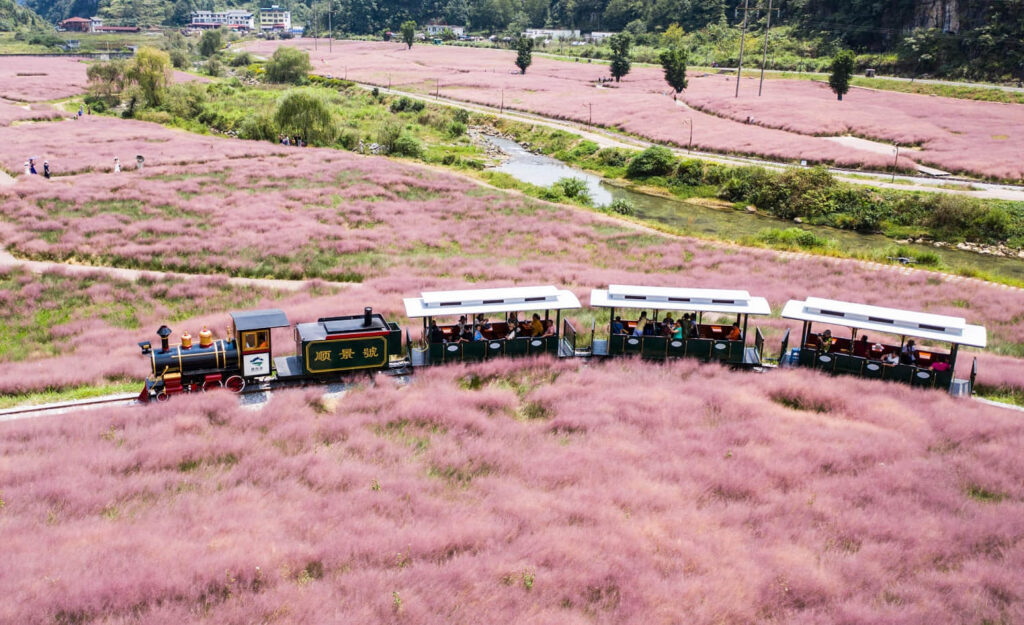
Every year from September to November, the Muhly grass in Changshun Shenquan Valley blooms like a dreamy pink haze, resembling a fluffy cloud ocean when it blooms in large areas.
You can ride a scenic mini train through this pink fairytale wonderland, or leisurely stroll in the pleasant evening breeze for a close encounter with spotted deer.
When the sunset paints half the sky red, don’t hesitate, aim your camera and collect all the beautiful scenes.
Gazing at the distant mountains from the grassland in the clouds on a sunny day.
In Baitang Township of Changshun, there’s a beautiful “Autumn Slope” grassland in the clouds.
In the past, “Autumn Slope” was where local Miao and Buyi youths courted each other. With social development, going to the “Autumn Slope” has gradually become a folk activity. Every year at the beginning of autumn, men and women, young and old, dressed in festive costumes gather together, singing folk songs, swinging on swings, performing acrobatics, creating a lively atmosphere.
Under the backdrop of autumn scenery, the grassland in the clouds shows its most beautiful side. If you’re not in a hurry, why not gaze at the mountains spanning out in the distance and watch the clouds rolling in from atop Autumn Slope.
In early winter in Changshun, golden ginkgo leaves create the most dazzling scenery.
In the Chinese Ginkgo King Scenic Area, there are seven ancient ginkgo trees that are thousands of years old. Among them, one that is over 4760 years old, known as the “Ginkgo King,” is currently the oldest known ancient ginkgo both domestically and internationally.
In late autumn, it stands tall between heaven and earth, donned in its golden armor, vigorous and shining. When you stand in front of the tree, why not pick up a fallen leaf from the ground and appreciate the charm of this life that spans time.
Tourist Tip: After driving to the Shenquan Valley Scenic Area, purchase entrance and sightseeing car tickets at the main gate (78 yuan per person) and take the car to the end to reach the Pink Sea of Flowers.
Folklore Tip: Changshun has Bouyei ethnic events on the third day of the lunar new year such as opening wine jars, Baiyun Mountain Temple Fair, flower jumping field, and Guangshun “God” lifting. These activities are used to pay homage to ancestors, pray for good weather and bless everyone with peace and health.
Self-driving tips: Changshun is about 116 kilometers from Anshun, with a driving time of about 1 hour and 46 minutes. From Changshun, take G354 past Bandang, switch to S209 and X482 past Mao Ying, then turn onto G321 and S209 to reach Anshun.
Stop 3: Anshun
Anshun is not famous in the central region of Guizhou, China. For most travelers, it’s just a place name that flashes past on the way to the Huangguoshu Waterfall, Dragon Palace, Ziyun Getu River, and Qinglong Twenty-Four Turns.
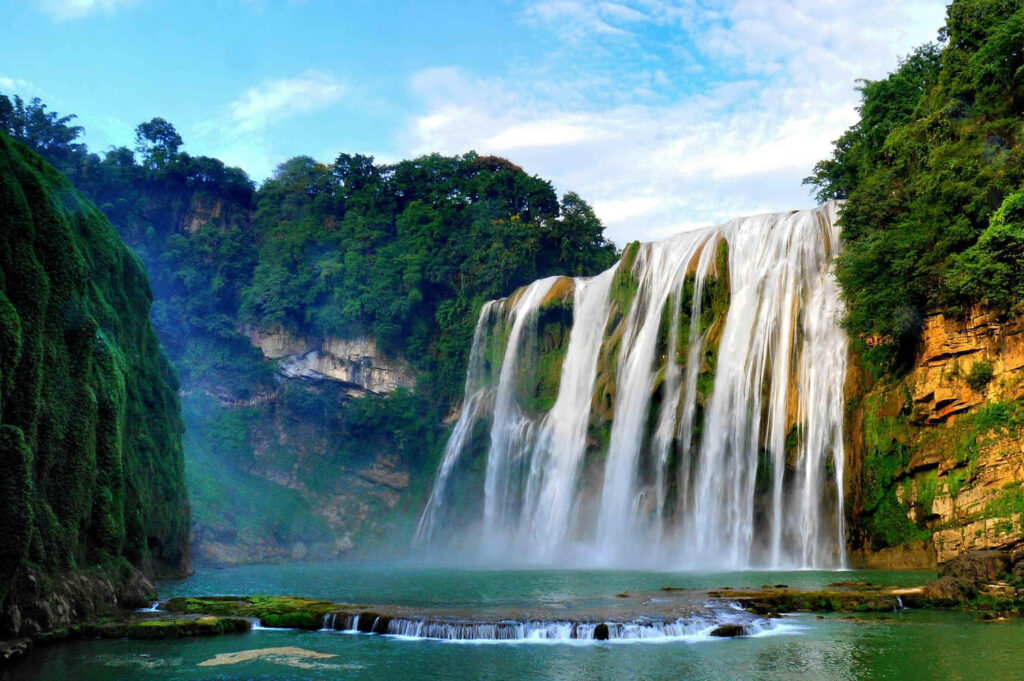
In fact, this is an “immigrant city” scattered with minority ethnic villages of the Bouyei and Miao tribes, with a history that can be traced back to the Ming Dynasty.
Anshun, as a strategic point being the “belly of Guizhou and throat of Yunnan, the lips and teeth of Guangdong and Sichuan,” was heavily militarized by Zhu Yuanzhang in the early Ming Dynasty to wipe out the rebellious forces in the Yunnan-Guizhou area. He dispatched hundreds of thousands of troops to this region and built military fortresses (pù) here as a base for frontier defense.
Once the rebellious forces were quashed, some soldiers stayed with their families, living around these fortresses. They became a special group known as the military fortress people. After the war, with a wave of Han Chinese immigration into Anshun, these fortress people grew stronger.
As Anshun Prefecture was established, more and more people came to this city, gradually making it a “dry port” and commercial center in central Guizhou, and for a time it was “first in the province.”
However, as history progressed, people seemed to “forget” this group of Han Chinese. After arriving in Anshun, you can visit the well-preserved stone buildings of Tianlong Fortress and Yunfeng Fortress to learn about the lives and customs of these people.
The fortress people have a deep reverence for natural spirits, and they hold various folk activities throughout the year. Small and large temples are everywhere, and they worship ancient figures like Yan Huang Haodi and Fuxi Xuanyuan.
In the culture of the fortress people, they have preserved a traditional drama—Anshun Ground Opera (also known as “Jumping God”).
On major holidays, performers use open spaces in the village as their stage. Dressed in long robes with small flags inserted behind their backs and wearing battle skirts around their waists, they hold long spears and short swords to perform ancient loyalty stories and myths such as “Fengshen” and “Three Kingdoms.”
Travel tip: If you don’t have much time, you can choose not to go to Changshun. After visiting Hongfeng Lake in Guiyang, follow G302, pass Tianlong Fortress and Yunfeng Fortress, and directly reach Anshun.
Cultural tip: In addition to fortress culture, Anshun is filled with relics from the Three Kingdoms period. Relevant events include Zhuge Wuhou’s famous southern expedition during the Shu Han period, Zhuge Liang’s seven captures of Meng Huo; there’s also Jin Dingchuandong ancient human culture, Zangke culture, Yelang culture, etc.
Self-drive tip: Anshun is about 141 kilometers from Qinglong, with a driving time of about 3 hours. Departing from Anshun, take G320 and X464 to reach Qinglong. Along the way, you’ll pass the Huangguoshu Waterfall, Guansuo Ridge, and Hongya ancient ruins.
Beipan River Section
This stretch of waterway meanders intricately. The warm, cool, moist highland subtropical monsoon climate brings abundant heat and plentiful rainfall, creating picturesque scenery.
Fourth Stop: Qinglong
The “Lifeline of the Resistance War” — Twenty-Four Turns.
Leaving Anshun, heading southwest along G320, crossing the Beipan River, we finally arrive at the iconic symbol of the Ledo Road — Twenty-Four Turns.
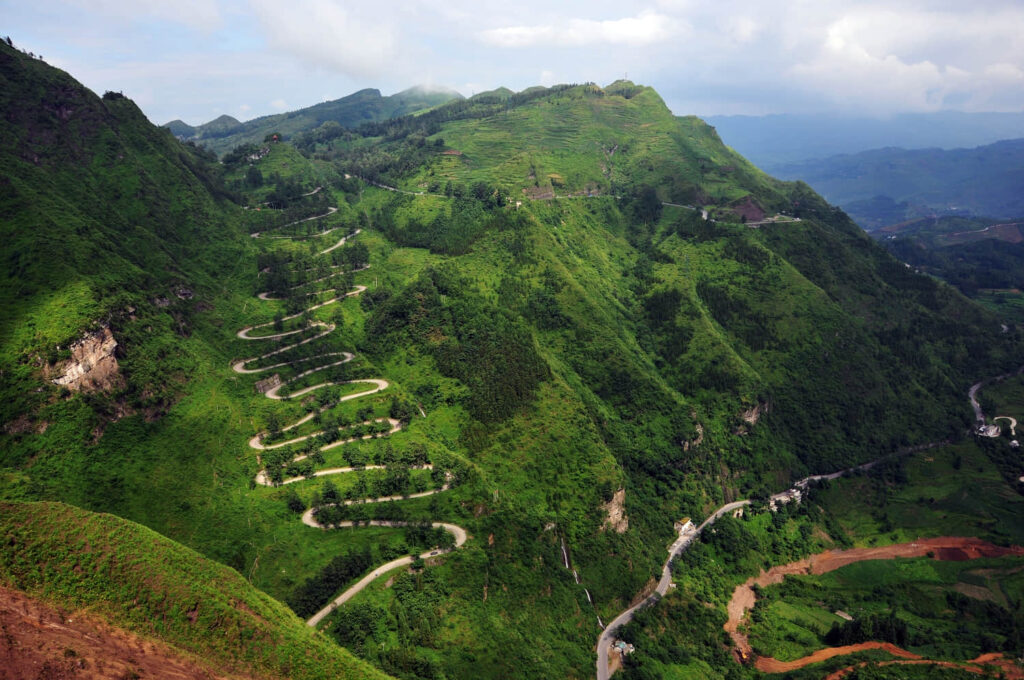
For veteran self-driving motorists, they have seen too many mountain roads composed of continuous hairpin bends like this.
Travel tips: The opening hours for the Qinglong Twenty-Four Turns scenic area are 8:30-17:30. Self-driving is no longer allowed today. You can go to the visitor center to buy tickets and take a sightseeing car to reach the mountaintop viewing platform to overlook the panorama. There is also a museum at the top of the mountain for visitors to tour.
Self-driving tips: Return from Qinglong along G320, then switch to Shuihuang Road, go through Langdai and Panlong to reach Liupanshui. The total distance is about 194 kilometers and the driving time is about 3 hours.
Yelang Cultural Section
This segment continues deeper into the Yunnan-Guizhou Plateau, passing through several ancient villages and towns along the way. The Yelang culture, established by the ancestors of the ethnic minorities, is also reflected in this section.
Fifth Stop: Liupanshui
Liupanshui, during the Spring and Autumn period, was the territory of Zangke, and during the Warring States period, it was under the jurisdiction of Yelang. The rule of more than five hundred years left this place with a rich and mysterious ancient Yelang culture.
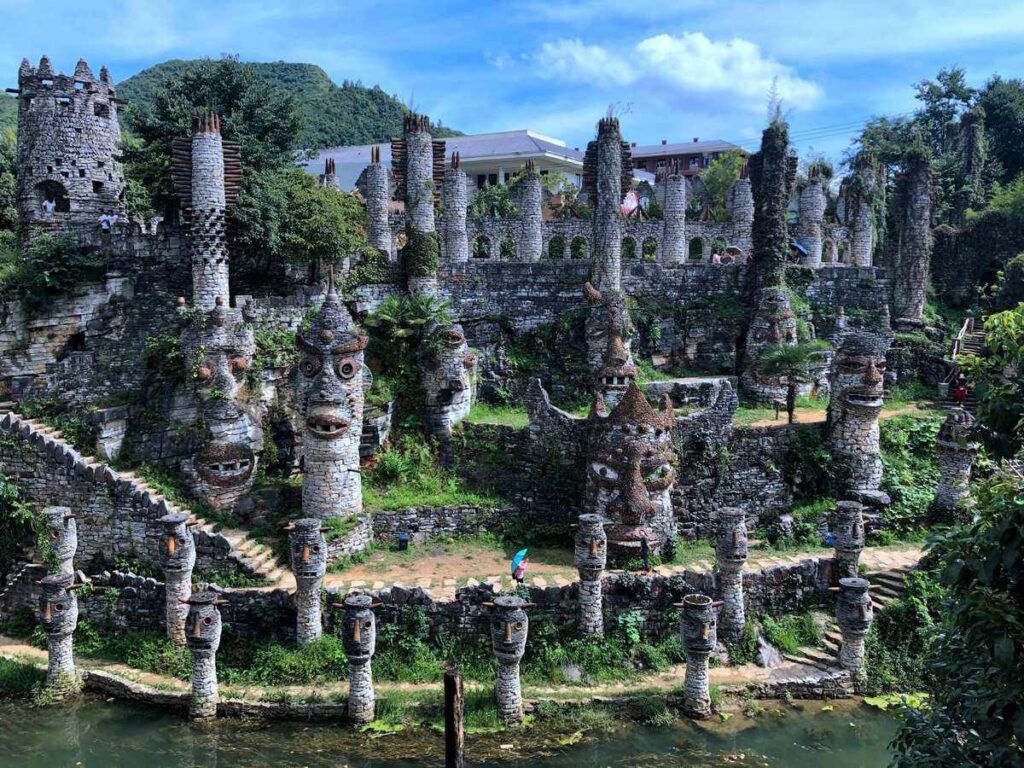
Ancient Yelang, along with ancient Loulan and Dali, are known as the three most mysterious ancient states in Chinese history. It was mainly composed of the Gelao people, integrating multiple ethnic groups such as Buyi, Miao, and Qiang.
When you mention “Yelang,” you may think of the idiom “Yelang thinks too highly of itself.”
But in fact, according to later historians, Yelang was really large, with the area of the country at its peak reaching nearly 400,000 square kilometers!
Although the specific boundaries of Yelang have always been a mystery, it can be confirmed that most areas of Guizhou were under its jurisdiction.
After analyzing historical records and local chronicles that recorded Yelang’s territory, such as “Historical Records,” “Book of Han,” “Book of the Later Han,” “Huayang State Annals,” “Yunnan General Records: A Study of Yelang,” “Anshun Prefecture Annals,” and “Zunyi Prefecture Annals” by Zheng Zhen, some netizens have drawn a rough boundary of Yelang.
Traveling along G320 highway, there are plenty of unique and beautiful mountains, rivers, and historical towns.
You can visit the Zangke River Scenic Area to appreciate the beautiful scenery of the blue waves blending with the sky and listen to the tragic legends of King Yelang choosing his capital, selecting his concubines, and being lured to his death;
Then you can take a stroll through Langdai Ancient Town, a must-visit place on the ancient Yunnan-Guizhou post road, and experience the rich and simple Buyi ethnic style;
Or you can go to the King Yelang Palace to see the realistically reproduced Yelang architectural complex and feel the majestic grandeur of the kingdom.
Scenic Area Tips: In addition to the river view, Zangke River Scenic Area also features Zangke Village, Jiawang Village, Laowang Mountain, Moon Cave, ancient city walls, Muzhen Stele, and Nanji Mountain which is rumored to be the summer palace of the King of Yelang. Large-scale activities such as gliding and rock climbing are held from time to time every year. Motorboat races and kayak still water championships have also been wonderfully staged here.
Self-Driving Tips: Liupanshui is about 122 kilometers away from Hezhang, with a driving time of about 1 hour and 50 minutes. Departing from Liupanshui, take the S212 through Dawan and drive along the route to reach Hezhang.
Prairie Scenery Section
What will come into view in this section is a beautiful green carpet on earth. Here, the ultimate scenery of “spring breeze running horses on the willow path, sunset arm eagles on the autumn prairie” is fully displayed.
Six Stop: Hezhang
The Axilixi Big Grassland.
The civilization of Hezhang is written by mountains and rivers, with the Wujiang River basin alone accounting for 80% of the county’s area. Built by the mountain and near the water, the grand river and mountains have nurtured the ancient charm of Hezhang.
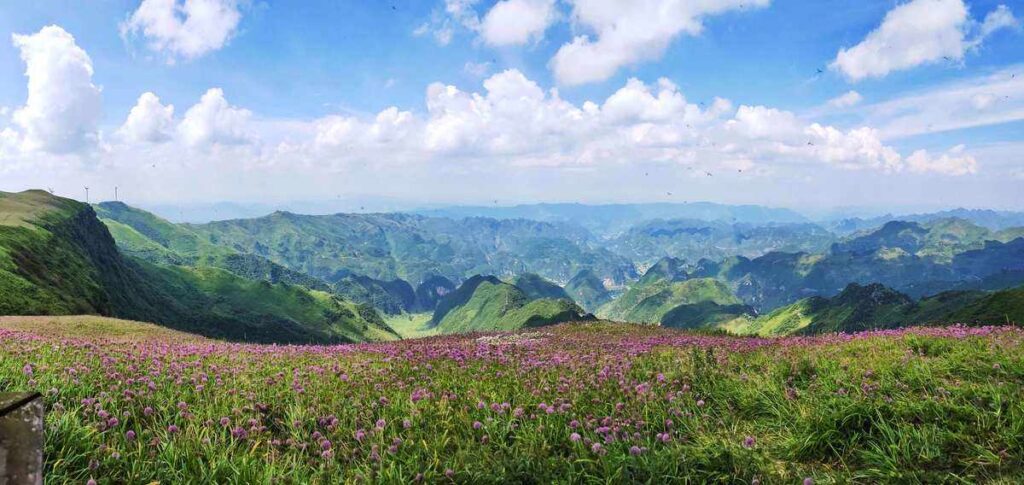
The Wumeng Mountain is the watershed of the Jinsha River and Beipan River, and its administrative region spans across 38 counties neighboring the three provinces of Yunnan, Guizhou, and Sichuan. It is a young mountain range formed by fault uplift.
Wumeng Mountain has two main peaks: Small Ahsilisi Chives Field and Large Ahsilisi Chives Field.
The former is 2900.6 meters above sea level, the highest peak in Guizhou, and is known as the “Roof of Guizhou”.
“Large Leek Flat”, true to its name, is home to the world’s largest area of wild leek flowers and is one of the only wild leek flower conservation areas in the country.
If you want to fully appreciate the sea of flowers, you need to visit the Ahsilisi Chives Field Scenic Area. (Asilisi is a Yi language term, meaning our friend)
Every year from July to September, tens of thousands of acres of wild leek flowers bloom competitively, graceful and charming. The entire mountain flat instantly transforms into a light purple ocean, hence it is also known as the “Provence of the East“.
Travel tip: The Asilisi Scenic Area is located at the junction of Xingfa Township, Shuitang Township, and Baiguo Town in Hezhang County. In addition, to protect the leek flowers on the mountain and the safety of tourists, camping is not allowed on Leek Flat Mountain. If you want to camp, you can find a camping site at the foot of the mountain.
Self-driving tips: Hezhang is about 291 kilometers away from Zhijindong, with a driving time of about 4 hours and 30 minutes. Starting from Hezhang, take S326 through Salaxi, switch to G246, G326 to Zhuchang, then switch to S309, G246 to Nayong, and finally take S106, S307 to Zhijindong.
Qianxi Cave Section
This is the last part of our journey, looping back to Qianxi. On the way, you can navigate through mountains and rivers, while continuing to appreciate the diverse and stunning views of the karst caves.
Seventh Stop: Zijin
The king of Chinese caves.
Zijin Not only does the name sound prosperous and blessed, but Zijin indeed possesses many earthly treasures. Among the more widely known, is the Zijin Cave, which has been rated as the most beautiful of the “Top Six Tourist Caves in China”.
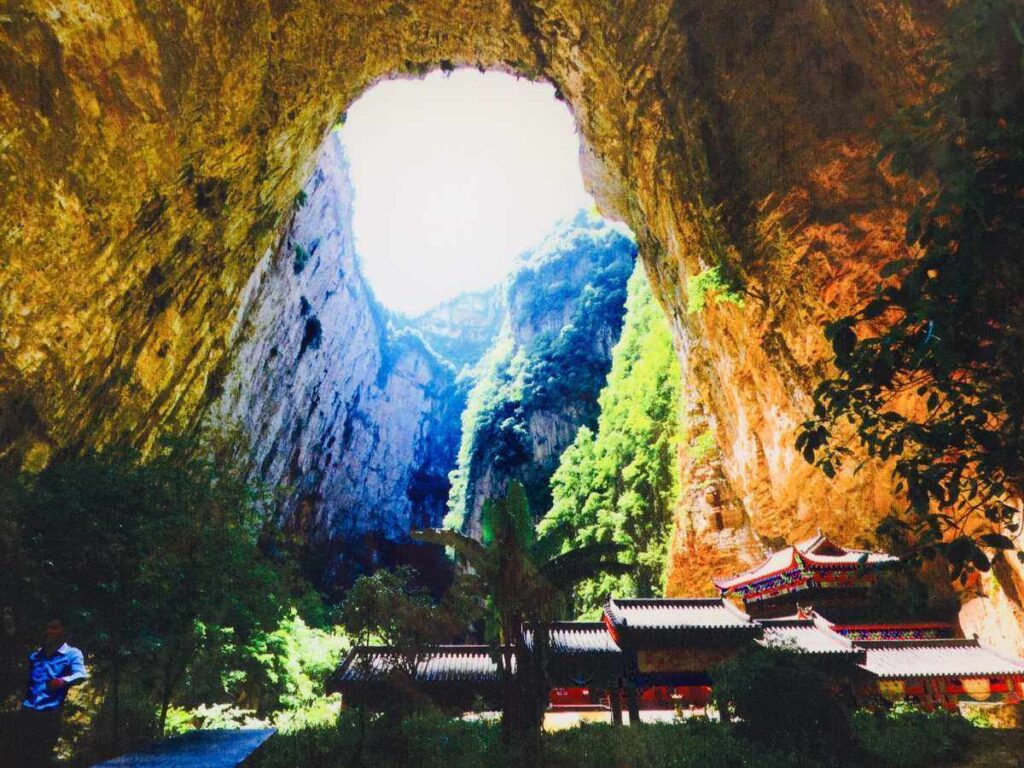
Walking in Zijin cave, the greatest feeling you may experience is “unbelievable”.
There are more than forty types of cave deposits such as stalagmites, columns, buds, and flags that are bizarrely shaped and vividly colored. The Wanshou Palace, Xuexiang Palace, Lingxiao Hall, Guanghan Palace, and Hundred Thousand Mountains all have a celestial aura and are full of spirit. This stone world carved by time brings you the magical beauty of nature.
Zijin, famous for its caves, isn’t only known for this feature.
The Zijin Grand Canyon, known for its “water on water, cave on cave, bridge on bridge, heaven outside heaven”, the Zijin Waterfall referred to as “pearl curtains pouring down”, and Pingyuan Ancient Town built on the basis of “Three Pools Reflecting the Moon” with Jiangnan characteristics, and more.
After touring the landscapes of Zijin, it’s time to head back to Guiyang.
Travel tip: The 6.6 kilometers walking tour in Zijin Cave takes about two hours; the air in the cave is humid and cool with a lower temperature, so pay attention to keep warm when entering. Photography is allowed in the cave, but be careful not to damage the fragile sedimentary rock on the side when taking pictures.
Conclusion
We have explored the Qianxinan Ring Road, admired the Huangguoshu Waterfall, and discovered some lesser-known places that are just as fascinating.
So, if you’re craving an adventure or want to explore new areas, don’t settle for the usual choices. Instead, consider taking the road less traveled and experiencing the excitement of discovering something new in nature.
We hope this blog has inspired you to add Guizhou to your travel wishlist or sparked your interest in learning more about China’s hidden landscapes. Until our next adventure, happy exploring!
